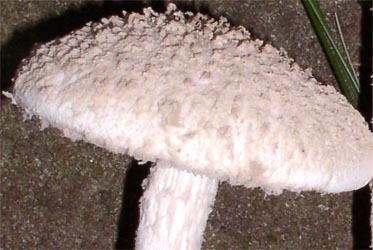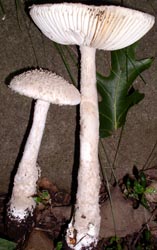|
[ Section Lepidella page. ]
[ Amanita Studies home. ]
[ Keys & Checklist/Picturebooks ] Amanita tephrea Bas nom. prov.
Technical description (t.b.d.) BRIEF DESCRIPTION: The cap of A. tephrea is about 40 - 95 mm wide, convex, unevenly hemispherical to unevenly convex to plano-convex to flat, nearly white when fresh, pale buffy gray when dried, shiny, waxy, onappendiculate, sometimes appendiculate with white to pale gray intense floccose, with a nonsulcate margin. The entire cap is pulverulent-floccose to pulverulent-verrucose from concolorous remnants of friable volva on an unpolished to somewhat shiny cap skin. The volva is present as warts that range from pale buff to pale gray and are very fluffy when fresh. This is due to the extremely limited number of hyphae in the universal veil. The volva can also be present as a powdery layer disrupting into floccose warts, pale beige at first with a slight yellow tint, becoming pale gray beige, easily removable. The flesh is white, 6 - 8.5 mm thick above the stem, and thinning evenly. The gills are narrowly adnate, subdistant to crowded, just reaching the apex of the stem, moderately broad to narrow, 7.5 - 8 mm broad, with the thickest part 75 - 80% of the radius from the stem, white to cream to pale cream, receding, breaking away from an adnate tooth, with a white to grayish subflocculose edge. The short gills are truncate to subtruncate to subattenuate to attenuate, unevenly distributed, of diverse lengths, and plentiful. The stem is 83 - 157 × 7 - 12.5 mm, cylindric, sometimes very slightly narrowing upward, flaring at the top of the stem, exannulate, at first very densely floccose, pallid at the apex to buffy gray above the bulb (e.g., 40 × 14 mm) to shiny white, slowly darkening from handling, with flocculence extending onto the bulb until the broadest point on the bulb, longitudinally fibrillose. The bulb is 47 × 27 mm, subfusiform, dog-legged to the stem. The volva is without distinct remnants or as gray and white flocculence to the soil line, becoming grayer and darker than the cap. The flesh is pale cream, stuffed above, white and firmly packed below. Odor is absent or mildly pleasant. The spores measure (9.0-) 10.0 -12.5 (-14.0) x 5.5 -7.0 (-7.5) µm (Bas, 1969) and are amyloid and ellipsoid to elongate to cylindric. Clamps are frequent at bases of basidia. Spores from more recent collections are similar: (7.5-) 8.6 - 12.4 (-17.1) x (5.2-) 5.6 - 8.0 (-9.6) µm. Amanita tephrea is found in oak-conifer forests in the eastern USA. Bas knew the species from North Carolina and Tennessee, U.S.A. It has recently been found on Long Island (New York) by Joel Horman and reported from the COMA foray (Connecticut) by Leon Shernoff. I have collected it in western South Carolina. It was also re-collected during recent work on the GSMNP ATBI in Tennessee. Bas included the present species in his stirps Chlorinosma. See the discussion of A. chlorinosma (Peck) Lloyd. -- R. E. Tulloss Photos: Margaret Horman (upper top and left - Long Island, New York); R. E. Tulloss (top center - GSMNP, Tennessee; lower - New Jersey)
[ Section Lepidella page. ]
[ Amanita Studies home. ]
[ Keys & Checklist/Picturebooks ] Last changed 22 March 2009. |



